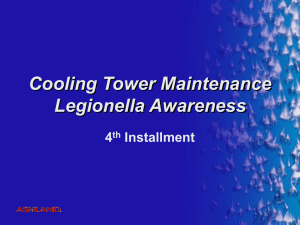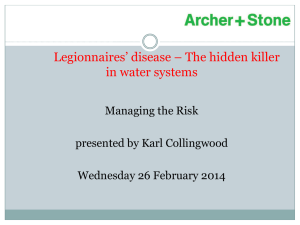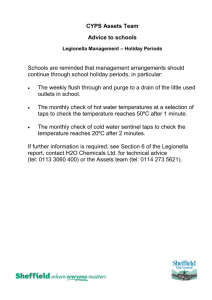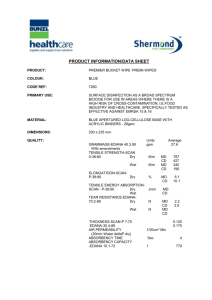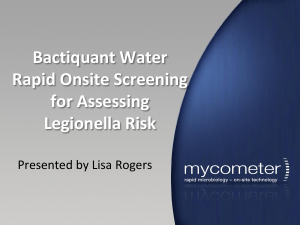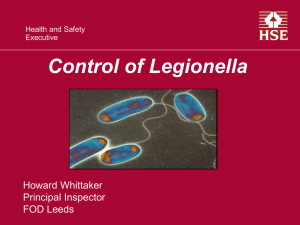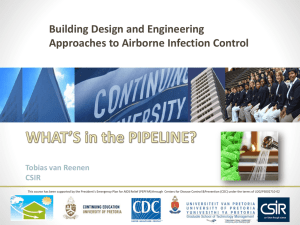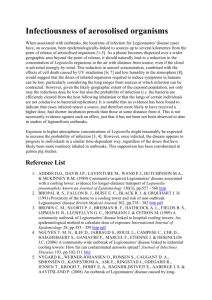Legionella Risk Management - Cooling Tower Maintenance Inc
advertisement
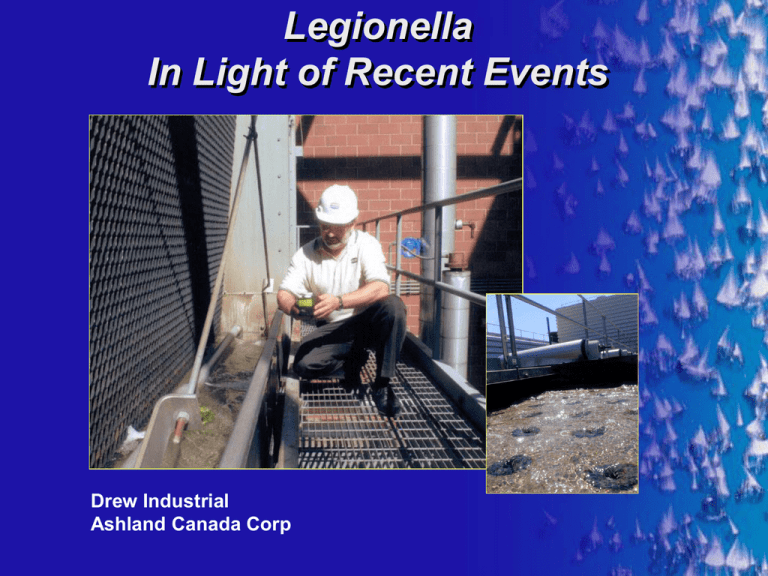
Legionella In Light of Recent Events Drew Industrial Ashland Canada Corp Legionella Bacteria Source of Legionella – Pervasive organism Conditions for growth – 68 - 122 F (20 - 50 C) – pH 6-8 – Stagnant waters – A nutrient source ® Biofilms, organics Sediments, deposits Factors Determining the Risk of Contracting the Disease A source of Legionella Favorable growth conditions Aqueous aerosol Sufficient organisms to cause infection Susceptible individual ® Systems Promoting Growth Cooling towers Evaporative condensers Hot and cold water systems Taps and showerheads Humidifiers and air washers Spa and whirlpool baths Decorative fountains ® We know that… In order to minimize Legionella growth: Chemical treatment alone is not effective Minimization is dependent upon design, maintenance, contaminants, awareness and consistent implementation Effective Legionella management requires a “best practices” approach: A system that is properly treated, serviced and supervised ® Total System Approach: Five Areas of Activity and Performance Comprehensive system assessment Intensive microbiological treatment program Sterilization and cleaning Monitoring and control Documentation ® ® System Assessment System survey – In-depth survey of system mechanical layout and operating conditions – Utilizes established protocol, ex BSRIABuilding Services Research Institute Assoc. (UK) Identify, evaluate and rank specific factors associated with potential for microbiological growth and Legionella – Mechanical and chemical Determine risk minimization action plans ® “Ideal System” Water flow is continuous No dead legs or stagnant conditions Basin and deck protected from sun No evidence of sludge, debris, algae Drift eliminators installed, functioning No evidence of aerosols, drift System not near health care, aged, residential facility ® Low number of people potentially exposed Halogen used Biodispersant/biodispersing biocide used Comprehensive water treatment program Automated biocide and chemical dosing Continuous automated monitoring, control Susceptibility to Legionnaires’ Disease Age – The very young and +40 year olds Gender – Males are twice as likely to contract the disease than females Heavy Smoker Heavy Drinker Individuals with weakened immune systems – Cancer, AIDS, HIV positive Chronic Medical Problems – respiratory, diabetes, asthma, renal dialysis Certain Drug Therapies – corticosteroids or other immunosuppressive therapies Organ Transplants ® Legionella Risk Management in Cooling Waters Outbreak Potential is typically the cumulative effect of many high risk variables – Population of those whom are susceptible – Type of facility – Susceptibility of the cooling system – Microbiological control capability – Monitoring and inspection frequency – Documentation provides a management and control feedback loop ® High Risk Facilities Hospitals Retirement Homes Long-term and chronic care facilities Public facilities – Offices – Malls – Hotels Process cooling systems that have the potential for: – Aerosol spray cooling – automotive – Process contamination - CPI/HPI - Food/Beverages ® Cooling System Susceptibility High airborne dirt load potential (utilization of side-stream filtration) – Nearby construction – Lack of ground coverings with aggregate materials or vegetation High nutrient load potential – Process side inleakage – Tower near chemical, food or vehicle exhaust ® Cooling System Susceptibility Cooling tower air discharge near proximity to fresh air intakes or open windows of building, and/or outdoor population (i.e. ground level). ® Cooling System Susceptibility No operation or intermittent operation of equipment while wet: – Drain if stagnant > 1 month – Idle - rotate weekly or install 5 – 10% slip stream flow Dead legs or seasonal cross-over lines – Remove them or – Loop them with 5 – 10% slip stream flow – Close shut-off valves at flowing supply and drain the remainder of the branch system and equipment ® Effects of Cooling System Dynamics – cfu/ml Same Day Comparative Samples (Example System Treated with Continuous Oxidant and Slug Feed of Glutaraldehyde Once Per Week) Flowing Bulk Water Basin Chip Scale Basin Sludge Dead Head (off) Plate/Frame XER Slip Stream By-pass (10%) Plate/Frame ® Aerobic Bacteria Fungi Anaerobic Bacteria Higher Life Forms <10 1600 <10 10 <10 1,000,000 No Yes 3,500,000 20 1,000,000 Yes 400 <10 10,000 Yes <10 <10 <10 No Microbiological Control Capability Efficacious biocides selection Biodispersant supplement for biofilm Effective application for required concentration and contact time – System dynamics (ART, T½) and volume – Dedicated automated feed of microbiocides – Feedback control Loop (ORP, self verifying feed pumps) Pre-conditioning/sterilization – Preseason start-up – Idle restarts – Sterilization/hyper chlorination at the summer peak – End of season shutdown ® Microbiological Control Additives of Choice Oxidation – Bleach (CSW 20) – Sodium Bromide/Bleach (Drewbrom) – BCDMH (Biosperse 261T) – Chlorine Dioxide Non Oxidants – Glutaraldehyde 1º (Biosperse 254/255) – Isothiazolin 2º (Biosperse 250) Biodispersants – Nonionic Surfactants (Drewsperse 739) – Protein cross linking/cationic surfactant blend (Performax 405) – Anionic surfactants (Drewsperse 7211) ® Legionella Control with Non-Oxidizing Biocides Chemical Compound Glutaraldehyde Isothiazolin 2 Bromo-2-Nitro Propane-1,3, diol (BNPD) Dithiocarbamates Di-bromo-nitrilo-propionamide (DBNPA) Active Concentration mg/ℓ Contact Time 25 - 54 1 Hour 2.25 - 2.6 6 Hours 25 400 24 Hours 60 Minutes 40.0 - 60.0 6 Hours 4-8 2 Hours Note: System potential contaminants and operational pH must be checked for compatibility with the non-oxidizing biocide ® Continuous Oxidant Feed Protocol Continuous feed for chlorine, bromine, BCDMH or stabilized bromine – Dosage: Recommended 0.2 - 0.4 FAH and/or equivalent mV ORP with a minimum requirement of a measurable residual FAH For higher risk systems increase FAH residual as needed to control CFU level and biofilm Feed a supplemental organic biocide* – Recommend biocide be glutaraldehyde or an alternate biocide fed with biodispersant – Feed once per week or as needed to control biofilm *Alternative choices of non-oxidizing biocide should be based on Relative Population Density (RPD) lab results ® Intermittent Oxidant Feed Protocol Intermittent Oxidant Feed – Chlorine, bromine, BCDMH or stabilized bromine – Minimum dosage: Hold 0.5 - 1.0 FAH and/or equivalent mV ORP for a minimum of 2 hours each day Feed alternating supplemental organic biocides* – Recommend one biocide be glutaraldehyde or an alternate biocide fed with biodispersant – Feed an additional compatible organic biocide* – Alternate feed once per week *Alternative choices of non-oxidizing biocide should be based on RPD results ® Chlorine Dioxide A Selective Oxidant ® Oxidation potential not affected by pH Selective oxidant No dissociation; does not react with water Does not react with amines, nitrogen compounds Highly effective against biofilm Continuous Chlorine Dioxide Feed Protocol Continuous chlorine dioxide feed – Minimum dosage: 0.1 ppm residual ClO2 or equivalent mV ORP Feed a supplemental organic biocide as needed based on biofilm control – Recommend biocide is glutaraldehyde or an alternate biocide fed with biodispersant* Feed once per week or as needed to control biofilm *Alternative choices of non-oxidizing biocide should be based on RPD results ® Intermittent Chlorine Dioxide Feed Protocol Intermittent chlorine dioxide feed – Minimum dosage: 0.5 ppm residual ClO2 and/or equivalent mV ORP for a minimum of 2 hours per day Feed alternating supplemental organic biocides* – Recommend one biocide be glutaraldehyde or an alternate biocide fed with biodispersant – Feed an additional compatible organic biocide* – Alternate feed once per week Chlorine dioxide is also an effective supplemental biocide for process cooling systems where contaminants that increase bacterial growth are present. *Alternative choices of non-oxidizing biocide should be based on RPD results ® Dual Non-Oxidizer Feed Protocol Slug feed of non-oxidizer – Alternately twice per week, evenly spaced – Timer/Pump (self verifying optional) automated feed is preferred over manual Oxidant feed once per week – Minimum dosage to hold 1 – 2 ppm FAH for 2 hours. Based upon system demand this may require the feed of 5 to 10 ppm active oxidant – Dosing a day prior to a nonoxidizer addition is the preferred method. ® Preconditioning and Sterilization Frequency – Minimum once per year for season equipment operation • End of season preferred – Minimum twice per year for year round system operation • During turn around on process systems and 6 months later • Beginning and end of cooling season – Confirmed Out Break ® Preconditioning and Sterilization Procedure • Ensure all air intakes and windows within at least 100 feet of the tower are closed • Open all cross over lines • Ensure complete recirculation of the total system and all equipment • Turn fans off and activate stand-by pump • Blowdown flush all strainers, risers, water boxes and dead legs. ® Preconditioning and Sterilization Procedure Cont’d • Add biodispersant (200 ppm) and non-oxidizer recirculate for 24 hours (120 – 360 ppm) • Blowdown/flush etc. • Add oxidant to produce 5 ppm FAH (due to system demand, dosage may be 15 to 25 ppm – 1.5 to 2.5 lbs. 10% bleach/1,000 gal) test verify 5 ppm at end of 6 hours • Drain system blowdown/flush etc. ® Preconditioning and Sterilization Procedure Cont’d • Water Wash/Hose out Tower • Upper deck Drift eliminators Fill Sumps and companion indoor sumps and storage tanks through to pump strainer If high pressure water jetting is employed then ensure suitable respiratory protective equipment is worn. ® Preconditioning and Sterilization Procedure – Cont’d • Leave drained for seasonal outage • If wet storage is employed, refill with inline blend of protecsol and 300 – 400 ppm of 1.5 % Isothiazolin non-oxidizer. • Immediate placement into service - Refill - Start pumps - Slug feed corrosion and deposit control compounds and non-oxidizer (i.e. prime the system volume) ® Sterilization Only Frequency – During restart of idle/stagnant towers, condensers, heat exchangers – Seasonal restart of HVAC system, which was preconditioned and sterilized the end of the previous season – Peak of summer cooling demand (i.e. beginning of August). – Known outbreaks in the area – Biological dip slide counts exceed 105 – 106 CFU/ml. Visible slime (i.e. biofilm) present. ® Sterilization Only Procedure • Deconcentrate via bleed-off and blowdown of dead legs, risers, water boxes, and strainers to achieve 2 cycles of concentration. Close bleed • Fans off • Add oxidant to produce 5 ppm FAH (Due to system demand, dosage may be 15 to 25 ppm – 1.5 to 2.5 lbs/10% bleach/1,000 gal). Test hourly to verify 5 ppm held for 6 hours • Blowdown dead legs, risers water boxes and strainers • Resume treatment program cycles of concentration • Add Non-oxidizing Biocide ® Monitoring and Inspection Inspection for visible slime or sludge's – Decks – Mist eliminators – Fill – Sumps – Corrosion or biofilm coupons ® Monitoring and Inspection Testing • Bulk water dip slides - Prior to non-oxidizing biocide addition - Minimum once per week - Target ≤ 104 CFU/ml • Coupon surfaces - if available - Prior to non-oxidizer and/or biodispersant addition - Every 30 to 60 days, but be consistent - Target ≤105 CFU/cm2 ® Direct Testing of Legionella Frequency Consideration • Prior to peak summer sterilization (i.e. beginning/mid August) for seasonally operated HVAC or after a sterilization. • After cleaning of a confirmed cooling tower sourced outbreak • If a confirmed outbreak has occurred in the area (≤3 km minimum) • Three times per year of 24/7 Industrial process cooling systems of higher risk noted earlier ® Legionella Testing – Pathcon/Biosans Ship via air direct 7 days to culture If positive, species and type is determined, requiring additional time E-mail results within 2 days after the 10th day after receipt by lab ® OSHA/Wisconsin Protocol Confirmed Cooling Tower Source of Outbreak 1. 2. 3. 4. 5. 6. ® Turn off tower fans Shock dose chlorine donor to 50 ppm FAC Add Biodispersant Hold 10 ppm FAC for 24 hours Drain cooling system and repeat steps 2 - 4 Inspect for biofilms. If present, drain and mechanically clean. OHSA/Wisconsin Protocol Refill system and operate for 1 hour at 10 ppm FAC Flush system Recharge system with water treatment additives for deposit, corrosion and biological control and return to service 7. 8. 9. Note test monthly: ® Legionella ≤10 CFU/ml HPC ≤105 CFU/ml Field Study on Biofilm Growth Phase Time Colonization 15 Minutes Growth Detection 2 Days Biofilm Formation (Exopolymer/ Minimum Biofouling) 5 Days Maximum Biofilm Growth (8 – 10 Cells Thick) 14 Days Fully Mature Biofilm Matrix 31 – 40 Days ® Documentation Why Document? • When a pneumonia outbreak occurs in a facility it allows for: - Speed in identifying the source for eradication purposes, removing a potential and continual threat. After all it may not be cooling system derived. - Clinical micro biologists and physicians to select appropriate antibiotics, dosages and monitor the progress without the presence of further stressors. ® Documentation To name a few: • Simplified line drawing of the cooling system and all equipment, dead legs cross over lines, chemical feed points/lines/control, system volume, recirculation makeup and blowdown rates • Key water test results/date - Chlorides or conductivity for cycles of concentration assessment - Make-up, blowdown water meter readings - FAH and/or ORP for Halogen concentration - Biological Tests – CFU/ml; CFU/cm2 - Start, end and expiry dates of dip slide lots for bio testing ® Documentation To name a few: • Chemical pump and timer settings • Biocide usage • Start-up/shutdown and other application logs of preconditioning/sterilization and sterilization only • Inspection/observations for slimes, muds, algae in cooling tower and on coupons and what was done to improve • Contingency plans procedures, and results/check offs when performed. ® Use of Proper Monitoring & Control Equipment is Critical! Microbiological Residuals, Corrosion, Scale & Biofouling On-line ® Action Levels Immediate response to positive test results On-line treatment requires a minimum of 14 days to produce results Unrealistic a system could be totally Legionella free ® Preventive Actions Legionella is as Common as “Dirt” Keep Systems Mechanically and Microbially Clean Minimize or Rotate Idle Equipment Employ Filtration and Keep Filter Media Clean Mist Eliminators Clean and Functioning Properly ® Preventive Actions Inspect and Test – – – – – ® Domestic Waters Fountains Spas Air Handling Units Humidifying/Dehumidifying Equipment/Coils Biofilms Biofilms Don’t Just Harbour Legionella, They: – – – – – Restrict Air Flow Restrict Water Flow Reduce Heat Transfer Reduce Heat Rejection Induce Localized Corrosion Biological Control – Higher Life Forms – None – Bacteria CFU/ml <104, > 105 Do something – Bacteria CFU/cm2 <105, >106 Do something ® Preventive Action Use your Biocides in a Prudent Manner And Remember Sterility Does Not Exist Except in Higher Life Forms ® Additional Information Upon Request Legionella: Minimizing Risks, August 2000, Water Engineering and Management Environmental Aspects of Legionnaires’ Disease, February 1988, Journal AWWA Legionella Treatment Strategies: First Response and Minimization Action Plan, 2002 International Water Conference Paper 02-12 Who Should Be Responsible for Legionella, ASHRAE Journal May 1999, Volume 41, No. 5, 62-68, ref. ISSN-00012491 Why Evaporative Coolers Have Not Caused Legionnaires’ Disease, ASHRAE Journal, January 1995, page 29-33 ® Additional Information Upon Request Legionellosis, Guideline: Best Practices for Control of Legionella, February 2000, Cooling Technology Institute Minimizing Risk of Legionellosis Associated with Building Water Systems, February 2000, ASHRAE Standard 12-2000 (ISSN 1041-2336) ® What Can You Anticipate ® Expert group review of design and maintenance of cooling towers in longterm care homes, hospitals and other facilities housing people with complex health needs. What Can You Anticipate Review of other existing HVAC/Legionella standards and development/adoption of a standard for use; • ASHRAE Guideline 12-2000“Minimizing the risk of Legionellosis associated with building water systems” • Cooling technology institute February 2000 Guidelines – “Legionellosis guideline: “Best Practices for control of Legionella” • Health and Safety Commission, U.K., approved code of practice and guidance – L8, “Legionnaires” disease, the control of Legionella bacteria in water systems” • The chartered institution of Building Services Engineers, U.K. TM 13- 2000, “Minimizing the risk of Legionnaires’ disease” ® Walker Report http://www.health.gov.on.ca/english/public/pub /ministry_reports/walker_legion/rep_intro... Report of the expert panel on the Legionnaires” disease outbreak in the city of Toronto – September/October 2005, December 2005. ® Industrial Hygienists Employ Certified Industrial Hygienists Employ HVAC Engineers – Can fully evaluate potable cold and hot Domestic Water systems – Can calculate cooling tower plume relationships and re-entrainment of plume into air intakes or windows – Can assess air handling systems ® Industrial Hygienists A firm such as: – Stantec Consulting – Resource Environmental Associates Complete air quality, risk assessments on all aspects of exposure to Legionella and other environmental conditions such as molds and asbestos Firms may also have a division that does complete sterilizations of systems – hot and cold domestic, air handling, etc. ® Ashland Ashland is capable of a cursory review of cooling systems to assist a customer in targeting certain areas, as related to: – System Cleanliness – Microbiocide addition – whether oxidizing or nonoxidizing biocide. – Capable of applying chemicals to meet the protocols – continuous chlorination, shock feeding – Mechanical/operational conditions that can lead to high risk – Assist in providing documentation tools – Can provide routine microbiological testing and has a sample protocol and a lab arrangement to test for Legionella ® Thank You ® Registered trademark and ™ trademark of Ashland Inc. Ashland Inc. © 2001 ®
